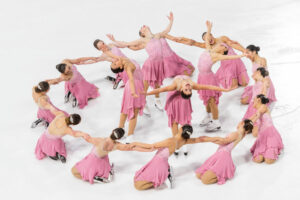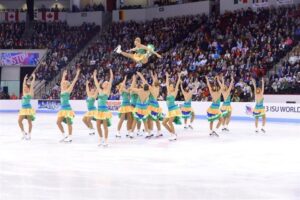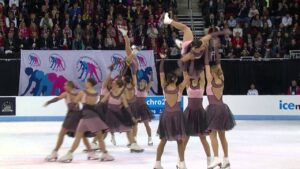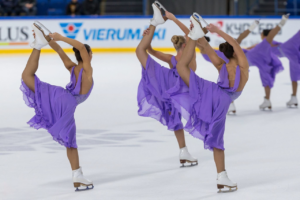Synchronized figure skating is a mesmerizing discipline within the realm of figure skating, harmonizing the elegance and artistry of ice skating with the precision and unity of synchronized motion. This captivating form of group ice skating features a team of typically sixteen skaters, executing intricate choreographed routines set to music. Although it has not yet found a place in the Olympic program, its rise in popularity is attributed to its awe-inspiring exhibitions of coordination, intricate technical elements, and artistic expression.

Synchronized figure skating is a testament to the skill, precision, and dedication of its participants. Skaters must master a wide range of complex movements and maneuvers while staying perfectly in sync with their teammates. This discipline demands not only individual prowess but also a strong sense of teamwork, communication, and trust among the members of the skating team. Judges evaluate performances based on elements such as technical difficulty, artistic expression, and overall presentation.
While it may not yet be part of the Olympic program, synchronized figure skating continues to evolve and captivate audiences worldwide. Its combination of artistry and precision makes it a unique and thrilling aspect of the world of figure skating, providing a platform for skaters to showcase their talent in a collaborative and visually stunning manner. As the discipline continues to grow and develop, it is likely to attract more participants and enthusiasts, further solidifying its place in the world of winter sports.

1. Formations: One of the fundamental aspects of synchronized skating is the creation of visually appealing formations on the ice. Skaters must transition smoothly between various shapes, lines, and patterns while maintaining perfect alignment and spacing with their teammates. These formations can range from simple circles and lines to more complex designs, adding an artistic dimension to the performance.
2. Elements: Synchronized skating routines include a variety of elements that demonstrate the skaters’ skills and teamwork. Some common elements include:
3. Footwork: Synchronized skaters incorporate intricate footwork into their routines to enhance the artistic aspect of their performance. This can include footwork sequences, spins, spirals, and creative dance steps, all synchronized to the music.

5. Synchronization: As the name suggests, perfect synchronization is crucial. Skaters must move together in harmony, matching the tempo and phrasing of the music. Deviations from the planned timing can result in deductions.
6. Musical Interpretation: Skaters must interpret the chosen music, matching their movements to its rhythm and emotional qualities. Musical interpretation is a key aspect of the artistic presentation in synchronized skating.
7. Required Elements: Competitions typically have a set of required elements that teams must include in their routines. These elements can vary from competition to competition but often encompass specific formations, moves, or transitions.
8. Judges and Scoring: Synchronized skating is evaluated by a panel of judges who assess both technical and artistic aspects of the performance. Judges consider the precision, speed, spacing, and execution of elements. Artistic elements, including choreography, musical interpretation, and overall presentation, are also taken into account. Deductions may be made for errors or violations of the rules.
Synchronized figure skating rules and elements are designed to challenge teams to achieve a high level of technical proficiency and artistic expression while maintaining perfect coordination with their teammates. Successful teams strike a balance between technical precision and artistic creativity, resulting in breathtaking and memorable performances on the ice.
